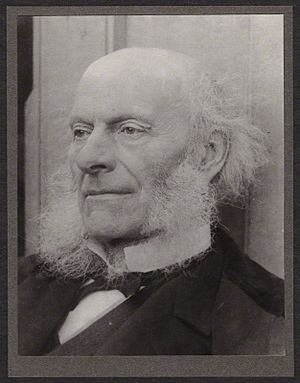Francis Penrose facts for kids
Quick facts for kids
Francis Penrose
|
|
|---|---|
 |
|
| Born | 29 October 1817 |
| Died | 15 February 1903 Wimbledon |
| Occupation | Art historian |
| Employer | |
| Spouse(s) | Harriette Penrose |
| Children | Emily Penrose, Francis George Penrose |
| Parent(s) |
|
| Family | Charles Penrose, John Penrose |
Francis Cranmer Penrose (born October 29, 1817 – died February 15, 1903) was a very talented English person. He was an architect, someone who studies old buildings (archaeologist), and even an astronomer who studied stars. He was also a sportsman who loved to row!
Penrose held important jobs. He was in charge of looking after St Paul's Cathedral in London. He also led the Royal Institute of British Architects and the British School at Athens.
Contents
Early Life and Education
Francis Penrose was born in a place called Bracebridge, Lincolnshire. He was the third son of Reverend John Penrose, who was a vicar (a type of priest). His mother, Elizabeth Cartwright, was a teacher and wrote children's books using the name Mrs. Markham.
Francis went to several schools, including Bedford Modern School and Winchester College. He later studied at Magdalene College, Cambridge. While at Cambridge, he was a keen rower. He even rowed for the Cambridge University Boat Club in the famous Boat Race three times, in 1840, 1841, and 1842.
Architectural Discoveries
Penrose trained as an architect from 1835 to 1838. After that, he traveled around Europe to study buildings. In 1843, while in Rome, he noticed something interesting about the roof of the Pantheon. He realized its angle had been changed from its original design.
Studying Ancient Greek Buildings
Penrose spent time in Greece, carefully measuring ancient buildings. He was one of the first to discover a special design trick used in the Parthenon. This trick is called entasis. It means that the columns and steps of the building were built with a slight curve. This made them look perfectly straight to the human eye.
The Society of Dilettanti, a group interested in ancient art, was very impressed. They sent him back to Greece to check his findings. His detailed work helped us understand how ancient Greek architects made their buildings look so perfect.
Working at St Paul's Cathedral
In 1852, Penrose became the Surveyor of the Fabric of St Paul's Cathedral. This meant he was responsible for the building's care and any new additions. This was his most important work as an architect.
Changes and Additions to St Paul's
Penrose designed new choir seats and a beautiful marble pulpit and stairs for the cathedral. He also created a memorial for Lord Napier of Magdala. He moved the Duke of Wellington's tomb to a new spot in the crypt.
He also made changes to the main entrance steps. He even uncovered parts of the old cathedral that were buried in the churchyard. In 1874, he designed new buildings for the cathedral's choir school.
Later Career and Achievements
Penrose became a Fellow of Magdalene College in 1884. He designed the entrance gate for Magdalene College and a part of St John's College in Cambridge.
From 1886 to 1887, and again from 1890 to 1891, he was the first Director of the British School at Athens. This school helps people study ancient Greece. Penrose had actually designed the school building himself!
He also served as the President of the Royal Institute of British Architects from 1894 to 1896. In 1898, he was appointed as an architect and expert on old things for the Royal Academy. He even wrote about the famous architect Sir Christopher Wren for a national biography book.
Family Life
In 1856, Francis Penrose married Harriette Gibbes. They had five children. Their second child, Emily Penrose, became a very important person in education. She was the Principal (leader) of several colleges, including Somerville College at Oxford.
Selected Works
Francis Penrose wrote several important books and papers about his discoveries:
- An Investigation of the Principles of Athenian Architecture (1851, with a second edition in 1888). This book shared his detailed measurements and findings about Greek buildings.
- He also wrote about predicting eclipses, showing his interest in astronomy.
See also
- List of Cambridge University Boat Race crews

